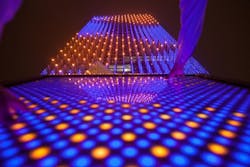Multilayer LED design blankets Peru bank façade (VIDEO)
A team led by Claudia Paz Lighting Studio has created a new LED-based façade lighting project on a Banco de Crédito del Peru (BCP) building in Lima, Peru.
A team led by Claudia Paz Lighting Studio has created a new LED-based façade lighting project on a Banco de Crédito del Peru (BCP) building in Lima, Peru. The 3D solid-state lighting (SSL) implementation is combined with an interactive control pedestal at ground level that allows the public to control the lighting, along with allowing the bank to present dramatic preprogrammed animations. The project, called BCP Affinity, is intended to convey the bank's pledge of open and transparent business practices.
Unlike the conservative and staid architecture often adopted by banks, BCP sought to create an iconic artwork installation for the city. At the same time, the bank wanted to connect the project to the citizens and allow the citizens to connect with their own selves through the project. The 1.7×1.5-m control console uses LEDs and multi-touch sensors to respond to hands touching the panel (as shown in the nearby photo) or even body movements. The input is in turn represented in dynamic tunable LED lighting on the high-rise façade.
Still, the 3D BCP façade implementation is different from other façade projects that we have covered such as the Miami Tower (http://bit.ly/1onVQ0J). The layered approach provides depth between a bold outer set of LED fixtures and a much more granular set of fixtures nearer the building's surface.
(Video copied with permission from Claudia Paz Lighting Studio)
In the six-layer design, the outer layer consists of Philips Color Kinetics ArchiPoint RGB (red, green, and blue), color-tunable fixtures that are mounted on the outer ends of 532 poles that extended perpendicular to the building. Those fixtures are sufficiently bright to be viewable in daylight. The inner five layers consist of Philips iColor Flex MX LED strips.
The outer lighting layer is purposely sparse and used for bold dramatic portions of an animation. The inner layers provide what the designers called sculptural effects. In total, there are 26,182 RGB addressable fixtures deployed in the Affinity project. The implementation covers an area measuring 50×19×1.2m.
The preprogrammed animations created for the BCP building are tied to natural phenomena combined with fantasy. For example, a Sand program uses shadows and the form of shifting sand dunes accompanied by the sound of wind. Some of the programs also allow the public to manipulate the display. For example, a Rain presentation allows a person at the control panel to part the show in an umbrella-like fashion.
There is also a Fireworks presentation with the combination of bold and dynamic colors and the accompanying pyrotechnic sounds. Meanwhile, a Light Orchestra combines effects representing instruments such as violins and cellos and allows the public to create their own symphony.
The Affinity project will clearly become a point of pride for Lima, situated at a busy intersection and visible across the skyline. Lead designer Claudia Paz discussed the motivation behind the project. "My motivation is the people, make them explore new experiences, feel emotions; if I can take a sigh from them I will be happy," said Paz. "I think this installation opens your mind to creativity. I do this for the new generations, where is my little girl of 5 years now — these new generations have to grow up seeing wonderful things, to always push themselves to explore new ways of creativity."

Maury Wright | Editor in Chief
Maury Wright is an electronics engineer turned technology journalist, who has focused specifically on the LED & Lighting industry for the past decade. Wright first wrote for LEDs Magazine as a contractor in 2010, and took over as Editor-in-Chief in 2012. He has broad experience in technology areas ranging from microprocessors to digital media to wireless networks that he gained over 30 years in the trade press. Wright has experience running global editorial operations, such as during his tenure as worldwide editorial director of EDN Magazine, and has been instrumental in launching publication websites going back to the earliest days of the Internet. Wright has won numerous industry awards, including multiple ASBPE national awards for B2B journalism excellence, and has received finalist recognition for LEDs Magazine in the FOLIO Eddie Awards. He received a BS in electrical engineering from Auburn University.






